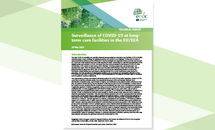Surveillance of COVID-19 in long-term care facilities in the EU/EEA
ECDC has worked with EU/EEA countries to develop a methodology for regular national reporting of existing national surveillance data on COVID-19 in LTCFs, aiming for maximum feasibility. This is to enable ECDC to communicate timely information on epidemiological trends of COVID-19 in LTCFs, in support of national and EU/EEA-level preparedness and response activities. The primary surveillance objectives are to monitor national-level trends in the number/proportion of COVID-19-affected LTCFs; and to monitor trends in the national incidence of cases and fatal cases of COVID-19 among LTCF residents.
Executive summary
Long-term care facilities (LTCFs) are commonly homes for elderly people with medical and social vulnerabilities. They include institutions such as nursing homes, skilled nursing facilities, retirement homes, assisted-living facilities, and residential care homes, among other facilities. In the European Union/European Economic Area (EU/EEA) prior to December 2019, there were an estimated 2.9 million residents in 43 000 of these LTCF types, representing approximately 0.7% of the total population.
Prior to the COVID-19 pandemic, there were no national incidence surveillance systems in the EU/EEA for healthcare-associated infections (HAIs) in LTCFs, due to the low feasibility of routine data collection in this setting. European-level surveillance of HAIs in LTCFs was achieved through periodic point prevalence studies (PPSs) in 2010, 2013, and 2016–2017. These surveys estimated that there were as many HAIs in LTCFs each year as in acute care hospitals in the EU/EEA.
Since the start of the COVID-19 pandemic, and as of November 2021, there have been over 800 000 fatal cases of COVID-19 (i.e. COVID-19-related/associated deaths) in the EU/EEA, with more than 88% in people aged over 65 years. By May 2020, deaths among LTCF residents accounted for 37–66% of all COVID-19-related deaths in EU/EEA countries, depending on the country (countries with available data).
From July 2020, after a period of low notification rates, EU/EEA countries started to experience a renewed increase in notifications of outbreaks and fatal cases of COVID-19 within their populations of LTCF residents. As a result, between August and November 2020, ECDC worked with EU/EEA countries to develop a methodology for regular national reporting of existing national surveillance data on COVID-19 in LTCFs, aiming for maximum feasibility. This is to enable ECDC to communicate timely information on epidemiological trends of COVID-19 in LTCFs, in support of national and EU/EEA-level preparedness and response activities. The primary surveillance objectives are to monitor national-level trends in the number/proportion of COVID-19-affected LTCFs; and to monitor trends in the national incidence of cases and fatal cases of COVID-19 among LTCF residents.
In December 2020, ECDC sent a draft surveillance protocol to EU/EEA countries for comments. On January 2021, EU/EEA countries started reporting surveillance data to The European Surveillance System (TESSy) according to the final protocol. Since 18 March 2021, ECDC has published outputs using such surveillance data on its website, within two days of the upload to TESSy. These are displayed within individual country reports, as trends in the incidence of COVID-19 cases, in the incidence of fatal COVID-19 cases, and in the proportion of LTCFs in the country experiencing a new cluster/outbreak. These data are also reported within the introductory weekly summary, as an automated text commentary on national trends.
The methodology in the surveillance protocol specifies two data collection streams. The first stream corresponds to the collection of aggregate national data on a weekly basis. To aid feasibility and promote acceptability, the protocol only contains 12 variables, none of which are mandatory. They are deliberately similar, to enable countries to report the subsets that best match their national data. The second stream is the ‘Periodic Survey’, sent to Coordinating Competent Bodies in EU/EEA countries at the start of national participation in this surveillance activity, and every 6-12 months thereafter. It records relatively stable denominator variables (e.g. the total number of national LTCF beds) and the national case definitions and caveats for the weekly national data.
To date, 17 EU/EEA countries have reported data to this voluntary surveillance system via TESSy. These are Austria, Belgium, Croatia, Cyprus, Denmark, France, Germany, Ireland, Italy, Lithuania, Luxembourg, the Netherlands, Norway, Portugal, Slovenia, Spain, and Sweden. Sixteen countries returned Periodic Surveys. At least two thirds of these have national (>98%) coverage of their reported LTCF sample. The average size of the participating LTCFs ranged from 19 to 205 beds (median 61 beds) by country, and the number of LTCF beds per population age ≥80 years (mid-2019) ranged from 3.3 to 12.7 (median 6.1 beds) by country.
Fourteen countries indicated their case definitions for COVID-19 and included types of LTCF. The majority used a national definition for cases (12/14 countries) and for fatal cases (14/14 countries) (see Table 4, Annexes 1 and 2). The national data for all countries that responded included LTCFs for the elderly and at least two included facilities for individuals with disabilities. At least three countries excluded rehabilitation centres.
These factors, as well as other national surveillance systems descriptors, such as changes in the national testing strategy and capacity over time, suggest that comparisons between different countries’ weekly national data should only be done cautiously.
The weekly national data contain a reporting lag of a few weeks. As of 25 November 2021 (2021-W47), seven countries had reported data for week 2021-W46; 12 countries had reported data for week 2021-W44; and at least 14 countries reported each week from between 2021-W15 to 2021-W40, inclusive.
As expected, half of the participating countries reported fewer than half of the 12 variables, with only one country (Spain) reporting all variables. The least reported variables were the weekly number of COVID-19 tests among residents (n=1 country), and two variables related to vaccination (n≤3 countries) that are partially duplicated in the ECDC Vaccine Tracker. All countries reported at least one variable related to COVID-19 cases, and at least one related to fatal cases.
The usefulness of this activity for countries is exemplified by the observation that at least six EU/EEA countries (Belgium, France, Germany, Ireland, Slovenia, and Spain) have reduced the regularity of their national reporting of COVID-19 in LTCFs, while continuing to report these variables to this ECDC system.
The secondary objectives of this surveillance system include analyses to support the assessment of the impact of COVID-19 on LTCFs in the EU/EEA. The case facility rate (CFR) in pooled data from six countries (Belgium, Germany, Ireland, Luxembourg, the Netherlands, and Sweden) reported cases and fatal cases continuously from Q4 2020 (i.e. since national testing capacities and capabilities had stabilised) until Q3 2021. Calculation of the pooled CFR, weighted for the number of reported cases, shows a decline from 23.2% in Q4-2020 to 13.1% in Q1-2021, 12.0% in Q2, and a slight increase to 13.8% in Q3-2021.
Considerations for EU/EEA countries
Countries that already participate in this surveillance activity are urged to continue their participation, especially if they have slowed the regularity of national reports, in order to enable other countries to maintain awareness of trends among their peers. Indeed, all countries are encouraged to consider publishing their existing national COVID-19 data from LTCFs to support better understanding of the pandemic.
Countries that currently do not participate are encouraged to consider reporting, even one single variable such as the number of confirmed COVID-19 cases in LTCFs or confirmed fatal COVID-19 cases in LTCFs.
Recommendations for ECDC
This surveillance activity should be continued, to enable ongoing achievement of the primary and secondary objectives. Activities to encourage countries to participate should be strengthened in order to permit EU/EEAlevel situational awareness. ECDC should consult with EU/EEA countries regarding which of the 12 weekly variables could be discontinued (e.g. the above-mentioned three least-reported variables), and whether to include additional variables to the weekly reporting and Periodic Surveys.
Download

Read more
Scientific and technical publications
European surveillance of COVID-19 in long-term care facilities in the EU/EEA: aggregate data reporting - Surveillance protocol version 1.1
This surveillance protocol seeks to enable countries to report their existing national surveillance data on COVID-19 in LTCFs easily and regularly. This will enable ECDC to report national trends in the EU/EEA, with the aim of providing all EU/EEA countries with timely information to support their preparedness activities for LTCFs.
Prevention and control of COVID-19 in long-term care facilities
Guidance and reports on surveillance and prevention and control of COVID-19 in long-term care facilities.
Publication data
Multimedia
Infographic: COVID-19 in care homes
This infographic provides guidance on infection prevention and control in long-term care facilities





